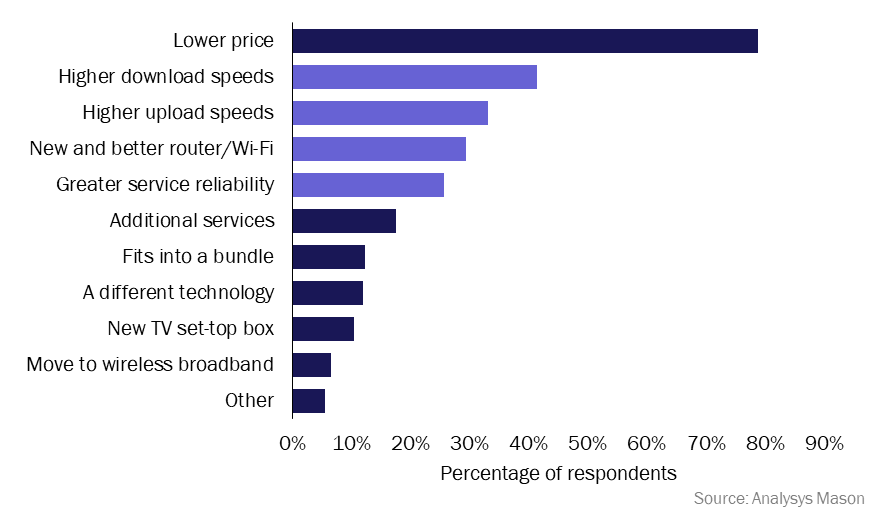XR and metaverse-type applications will accelerate data traffic growth: AIOps and improved Wi-Fi will help
In Analysys Mason’s fixed network data traffic report, we forecast that the development of metaverse-type applications will cause data traffic growth to accelerate towards the end of this decade. The metaverse is the superset of existing and future virtual spaces that either enhance physical reality or are entirely virtual worlds. In February 2024, the CEO of Epic Games described its partnership with Disney as one that will ‘build a persistent, open and interoperable ecosystem that will bring together the Disney and Fortnite communities’. This is one such metaverse-type ecosystem. As metaverse and broader XR services evolve to become increasingly cloud-based, consumers will demand higher bandwidths and lower latencies within their homes to support them.
This poses a challenge to existing in-home networks, which struggle to provide whole-home coverage or low latencies to multiple users. Operators will have to provide in-home connectivity solutions that can accommodate increasingly demanding metaverse-type applications reliably, and proactively solve any issues affecting customers’ quality of experience (QoE). Deploying AI solutions may also help with this.
We forecast a modest ‘metaverse effect’ on fixed network data traffic before the end of the decade
Current XR applications, including those rendered on the new Apple Vision Pro, are not fully formed ‘metaverse’ applications. In the ‘real’ metaverse, all users will experience the same persistent virtual and augmented spaces in near-real time – but the technology is not capable of this yet. We therefore refer to ‘pre-metaverse’ or ‘metaverse-type’ services. To make something closer to the ‘real’ metaverse happen, a lot of processing and video rendering will be carried out in the cloud. This will cause growth in network traffic. We forecast a steady increase in traffic as existing metaverse-type technologies evolve and rendering/compute shifts to the cloud in the next 5 years (Figure 1).
Figure 1: Fixed data traffic, worldwide, 2022–2028

Operators need to ensure that customers’ in-home networks can support cloud-rendered XR and, in future, the metaverse
The move to cloud processing for XR applications and the metaverse will be limited by consumers’ in-home networks. Services based on the Wi-Fi 5 or 6 standards may not meet consumers’ expectations when multiple users attempt to use metaverse-type services at the same time.
In-home connectivity can be a bottleneck for similar services that consumers currently use, such as online gaming. Data from our 2023 consumer survey shows that gamers’ satisfaction with service elements related to in-home connectivity (such as latency, Wi-Fi range and reliability) does not increase in-line with their headline download speed. This suggests that consumers cannot access the full benefits of their high-bandwidth broadband plans, due to issues with their in-home networks.
It is in operators’ interests to address this issue. In-home connectivity is important to consumers when deciding to change their fixed broadband plans. Data from the survey shows that, after price, the most-important issues that customers consider when changing broadband plans relate to in-home connectivity (Figure 2).
Figure 2: Service elements that would attract respondents to new fixed broadband plans, 16 surveyed countries, 2023

Question: “Which one of the following factors would most attract you to a new fixed broadband package?/How could your current fixed broadband plan be improved?”; n = 14 546.
Operators can improve in-home connectivity by offering advanced in-home networking solutions to their customers. Newer Wi-Fi generations will provide greater bandwidths by making more channels available over spectrum bands. Wi-Fi 7 will reduce latency and interference within consumers’ homes through multi-link operation, which allows compatible devices to connect to multiple frequency bands at once. Similarly, fibre-to-the-room (FTTR) technology can remove issues of contention when multiple people use the same frequencies. The wireless signal in an FTTR deployment does not need to pass through walls, which significantly improves performance.
AIOps can help operators to address the need for proactive home network management
Current processes for supporting home networks are fragmented because lots of legacy, and customer-bought, equipment remains in the home LAN/WAN. This means that operators receive an incomplete view of overall customer QoE. Resolving issues with in-home networks is therefore challenging, as customer support agents move between systems and manual processes.
As consumers’ expectations of home networks increase with cloud-based XR applications, operators will be pushed to make a trade-off between the cost of resolving issues and fulfilling customers’ demand for advanced in-home connectivity and service profitability.
AIOps is an important tool to ensure that home-networking issues are resolved quickly and affordably. AIOps refers to the application of AI insights to IT and network operations. Operator datasets are aggregated to provide a consolidated view of network performance. This is managed within a common big data environment and exposed to an AI platform. Insights generated from AI models are then fed to predictive care and service management systems to provide insights and automate workflows.
Regression analysis of data from Analysys Mason’s 2023 consumer survey shows that consumers’ perception of customer service is the service element most closely correlated with improvements in Net Promoter Scores (NPSs). Using AIOps to resolve issues more quickly will therefore logically benefit operators.
Operators can also reduce costs through AIOps. Fewer, and quicker, customer support calls will reduce opex associated with call centres. Providing customer support agents with more insights into network performance will also reduce the need for site visits, which will reduce opex.
The launch of the Apple Vision Pro, and future initiatives by Epic Games, Meta, and others, are all going to make the need for improved in-home networks more pressing. AI can help operators to handle the increasing volume of traffic that we see heading their way.
Article (PDF)
DownloadAuthor

Martin Scott
Research DirectorRelated items
Article
Operators need ways to pre-empt tech players gaining ground in the consumer telecoms market
Article
Telstra highlights the failure of established operators to address the threat posed by low-cost challengers
Article
Operators could maximise the capabilities of existing in-home equipment by offering Wi-Fi motion sensing

